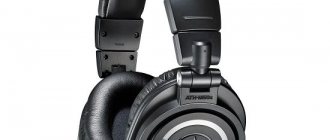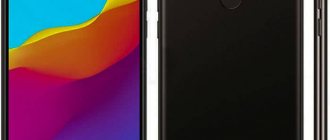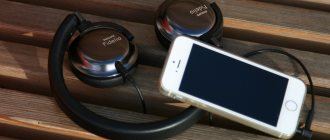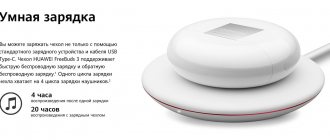Characteristics, equipment and brief +/-
Galaxy Buds Live specifications:
- Construction: in-ear
- Emitter type: dynamic
- Speaker Diameter: 12mm
- Connection type: completely wireless
- Bluetooth: v5.0
- Codec support: SBC, AAC
- Range: 10 m
- Active noise cancellation: yes, Talk through (transparent mode)
- Moisture protection: IPX2
- Control: touch
- Operating time: 6 hours (ANC and Bixby activation enabled), 8 hours (ANC and Bixby disabled)
- Operating time with case: 21 hours (ANC and Bixby activation enabled), 29 hours (ANC and Bixby disabled)
- Earphone battery: 60 mAh
- Case battery: 472 mAh
- Charging input: USB Type-C
- Wireless charging case: yes
- Earphone weight: 5.6g
- Case weight: 42.2 g
- Earphone dimensions: 16.5 x 27.3 x 14.9 mm
- Case dimensions: 50 x 50.2 x 27.8 mm
- Price: $190 (RUB 13,990)
Brief pros and cons ⚖️:
7.5Average author rating
pros
- Good sound
- Comfortable and secure fit
- Unusual and interesting design
- Comfortable autonomy (6 hours with ANC)
- Useful features.
Minuses
- Active noise cancellation isn't the best
- Semi-open design (sound leaks in both directions)
- May be too big for small ears
Equipment:
- Headphones
- Charging case
- 2 pairs of silicone fasteners
- Charging cable (Type-C)
- Documentation
Galaxy Buds live kit
Samsung Galaxy Buds Live VS Galaxy Buds Plus
Should I upgrade from Buds Plus to Buds Live?
| Difference | Galaxy Buds Live | Galaxy Buds Plus |
| 1.Form factor | Inserts. | Intrachannel. |
| 2.Design. | More original, the sizes are slightly different, they almost never fall out. | They look normal and protrude noticeably from the ears. |
| 3.Other colors. | No blue. Perhaps new options will be released soon. | There is no bronze option. |
| 4.Sound. | The sound is more interesting. There is also an additional “bass channel”. | Both models have 2 emitters per body. |
| 5.Autonomy | With noise reduction and Bixby off - 8 hours. With on - 6 hours. With a case up to 29 hours, with noise reduction and Bixby - 21 hours. | They work longer on a single charge – up to 11-12 hours. With case 21 hours. |
| 6.Active Noise Cancellation. | Active noise cancellation. | — |
| 7.Soundproofing. | Worse. | Better. |
| 8.Case. | Takes up less space. | Takes up more space due to its oblong shape. |
| 9.Samsung Scalable Codec. | + | — |
Galaxy Buds Live cannot be called a replacement or analogue of Buds + . These are completely different headphones. Appearance and form factor vary. This is an option for those who do not like plugs. Or for those who like an open presentation (as a counterbalance to gags, which in 90% of cases have the entire scene “in their head”). Considering that the prices for both models are very similar, you can choose the option you like, taking into account the above. And buying a new product, already having Buds+, only makes sense if you don’t like the form factor.
2.1 Brief comparisons with main competitors
Samsung Galaxy Buds Live vs Apple Airpods Pro vs Huawei FreeBuds 3
| Difference | Galaxy Buds Live | Apple Airpods Pro | Huawei FreeBuds 3 |
| 1.Form factor | Inserts. Half open. | Intrachannel. Closed acoustic design | Inserts. Semi-open with ANC |
| 2.Design. | More voluminous. | Different form factor. Protrude from the ears, plus more. | Visually – a clone of AirPods. |
| 3.Sound. | At the level of FreeBuds 3. Worse than Airpods Pro with iPhone, about the same - with Android. | The sound is overall better. More detailed and balanced, especially in the Apple ecosystem. | The sound is at the Live level, the difference is at the level of taste preferences. No AAC codec support. |
| 4.Autonomy | With noise reduction and Bixby off - 8 hours. With on - 6 hours. With a case up to 29 hours, with noise reduction and Bixby - 21 hours. | Below. Up to 5 hours on one charge. With recharges from the case – up to 24 hours. | About 4 hours on one charge. Up to 20 hours with charging from the case. |
| 5.Active Noise Cancellation. | Active noise cancellation, better than FreeBuds 3 | Better. Both the technology itself and, thanks to the form factor and closed design. | It's almost unnoticeable and slightly cuts out low-frequency noise. |
| 6.Soundproofing. | Better than FreeBuds 3, but worse than Airpods Pro. | Better, especially with active noise cancellation. | Worse than Galaxy Buds Live and Apple Airpods Pro. |
| 7.Case. | More dimensional. | The most compact | The cases are very different, very compact. |
| 8.Functional | Bluetooth 5.0. IPX2 protection. You can reassign some gestures in the app. | Bluetooth 5.0. IPX4 protection. Touch controls cannot be reconfigured. There are native widgets in iOS. | Bluetooth 5.1. IP54 protection. Partial control customization is also available. |
| 9.Control | Touch, more convenient than FreeBuds 3, less convenient than Apple Airpods Pro. | A hybrid of touch and mechanical control, there is a “pseudo-button”. Pause when removing the earphone. | Touch control by touch. Pause when removing the earphone. |
| 10.Compatibility | Good with Android. Galaxy Wearables and Galaxy Buds apps for iOS. | Works better with iOS. They work worse with Android. There is no animation and some functions. | Best compatibility between Android and Huawei smartphones. There is “that same” animation. Application for Android, not for iOS. |
| 11.Charging connector | USB Type-C | Charging case – lightning. Wireless charging is supported. | USB Type-C plus wireless capability. |
| 12.Price | 190$ | 260$ | 125$ |
Review of completely wireless headphones Samsung Galaxy Buds+
Along with the flagship smartphones of the S20 line (our review of the Galaxy S20 Ultra can be read at this link), Samsung also introduced an accessory. An accessory that the company hopes will allow it to take a larger share of one of the hottest sectors of the consumer electronics market today - the sector of completely wireless headphones. In this Galaxy Buds+ review, let's see how close Samsung managed to get to the ideal.
The previous Buds (without the plus one) were released in the spring of 2019, simultaneously with the flagship smartphones of the S10 line. They have largely developed the ideas inherent in their predecessor - the Samsung Gear Icon X (review from the year before last at this link). The new headphones with a current recommended price of 10,990 rubles (there are already cheaper ones in some places) are also not revolutionary, at the same time, a lot has been improved.
Firstly, the sound. The headphones now have two speakers each, respectively for bass and treble (see illustration below). They are tuned by AKG with the mass audience in mind, which, as a rule, does not mind adding a little bass to almost any music. Accordingly, the Buds+ speakers are the most responsive in the low frequency range. Samsung's new TWS headphones are best suited for listening to hip-hop, pop or electronic dance music. But jazz or classical recordings are often not impressive - when many different instruments fill the entire frequency range, the bass “hides” mid- and high-frequency details that are important for such works.
The “ears” are isolated perfectly: you can comfortably listen to music on the subway at a volume of two-thirds of the maximum. The main thing is not to be lazy and choose from a wide range of soft tips of different sizes exactly those that suit your ears. If, after inserting headphones, you can still clearly hear what is happening around you, you should try larger or smaller earplugs. After which you wonder whether active noise cancellation is really necessary in vacuum headphones - although the Buds+ do not have it, passive isolation is quite effective.
Galaxy Buds+ support three codecs (an algorithm that allows you to compress a digital audio stream with minimal loss of quality) - traditional (and least quality) SBC, Samsung's own Scalable Codec (works only with Samsung smartphones, changes the compression level depending on the quality of the Bluetooth connection) and AAC . There is no aptX codec, but AAC also copes well with the task, especially since most music streaming services use it.
For TWS headphones, how they “hear” is also very important - after all, they are much more often used during conversations. Buds+ have two external and one internal microphone in each earbud, which provides clearer sound when talking.
The Galaxy Buds+ have significantly improved not only the sound, but also the battery life. You can use fully charged headphones for up to 11 hours without a break, without removing them from your ears until the built-in batteries are completely empty - this is a whole working day, plus the trip to or from work. No other modern TWS headphone model can provide such long battery life.
In this case, it is enough to return the discharged headphones to the case for three minutes so that the depleted battery is charged for another hour. The total energy reserve in the case is only enough for one more full charge - that is, the total autonomy of fully charged headphones and the case is 22 hours. The case is certified for wireless charging according to the Qi standard, and it can also be charged from Samsung smartphones that support Wireless PowerShare reverse wireless charging technology.
As for the design of the headphones, it has not changed much compared to the Galaxy Buds - except that the matte surface of the charging case has become glossy, the markings for the right and left headphones inside the case have become more visible, and the inside of the case itself is now also white. By the way, the cases from Buds and Buds+ are interchangeable; new headphones are charged in the case from the old ones and vice versa.
The quick “one-touch” pairing with Samsung smartphones and controls have not changed: with one slap of a finger on the earphone you can pause the music, a double slap switches to the next song in the playlist or answers a call, and a triple slap returns you to the previous song. Holding your finger on the touch pad calls up the voice assistant, or (this can be changed in the settings) turns on the “transparency” mode to hear what is happening around you, or (and this is perhaps the most useful thing) allows you to adjust the volume without taking your smartphone out of your pocket.
An application for managing headphone settings—selecting actions for gestures and equalizer sounds—is available not only for Android, but also for iPhone. True, in my testing, the quality of communication (mainly the frequency of stuttering when listening to music) with Android smartphones (Samsung Galaxy Note 8, Huawei Mate 30 Pro) was noticeably better than with the iPhone 11 Pro. Probably, Buds+ are still better optimized for devices running Google’s mobile operating system.
It wouldn't be fair to compare the Galaxy Buds+ to fully wireless headphones that cost twice as much. Yes, there is no active noise cancellation like the AirPods Pro, the sound is simpler than the Sony WF-1000XM3, the ears get tired faster than with regular AirPods (but the headphones stay in the ears much better). At the same time, Buds+ provide record autonomy, reproduce sound (and transmit your speech to the interlocutor) much better than their predecessors, and they cost quite a reasonable amount of money. In terms of euros from depreciated rubles, it is less than in Europe. If you have an Android smartphone (especially a Samsung) and are looking for completely wireless headphones, without chasing audiophile sound, the Galaxy Buds+ are one of the best options.
Appearance and build quality
In a small bright box there are:
- True Wireless headphones Samsung Galaxy Buds Live;
- Charging case
- USB cable (Type-C);
- 2 pairs of fastenings (one is already put on);
- Documentation.
At first glance, it seems that the part on which the mount is put on is the emitter. Visually very similar (although the terminals here seem to hint











